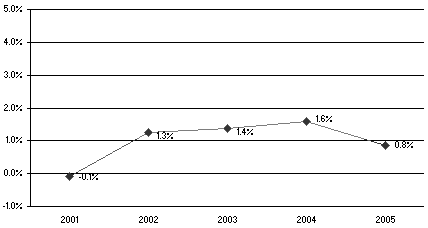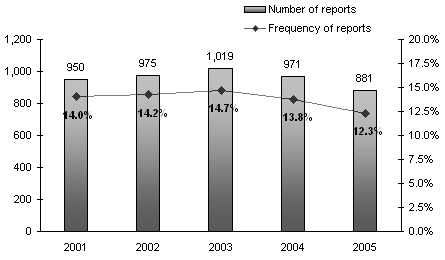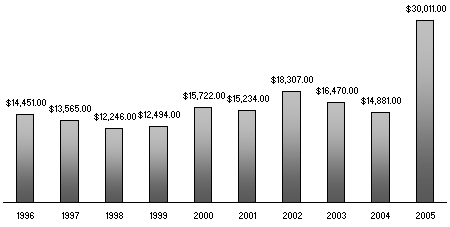The Lawyers Insurance Fund (LIF) manages the Law Society’s insurance program for BC lawyers. The program provides:
- professional liability insurance to protect lawyers if they are liable for negligence and to ensure that clients receive the compensation to which they are entitled (Part A of the policy);
- trust protection coverage to ensure that innocent members of the public do not suffer a financial loss through theft by a BC lawyer (Part B of the policy).
Assessment
The 2006 insurance premium for Part A professional liability insurance remains at $1,500 for the seventh consecutive year, the lowest premium since 1986. This premium has been possible over the years because of effective claims management by LIF and a stable loss experience. However, a low premium is expected to reduce the Fund surplus and may not be sustainable in the long term.
No premium will be charged or assessment levied for Part B trust protection coverage this year.
Compulsory policy wording
There is a 2006 endorsement that renews the 2005 policy, with some minor wording changes. The 2006 policy consists of the consolidated policy issued in May 2004, which introduced Part B (trust protection coverage), and endorsements issued in 2005 and 2006. This year brings only a few changes to the policy wording.
Condition 4.3 is clarified to reflect the circumstances in which the insurer may deem notice of a matter given by a third party as notice by the insured lawyer. The other changes, specific to Parts A and B, are noted below:
Part A (professional liability insurance)
The definition of “personal injury” is revised by removing from the definition “(a) false arrest, detention or imprisonment;” and “(b) wrongful entry or eviction or other invasion of the right of private occupancy.” These words are removed as they are concepts that are not relevant to professional liability insurance.
Insuring Agreement 3.5, relating to the Federation of Law Societies National Mobility Agreement, is clarified. The Insuring Agreement expands coverage in certain circumstances for a lawyer in private practice who is practising temporarily in a reciprocating jurisdiction or practising the law of that jurisdiction. The addition clarifies that the Insuring Agreement applies only if the lawyer’s temporary practice is as a private practitioner, not as in-house counsel. For more information on the insurance provisions incorporated pursuant to the National Mobility Agreement, please see Insurance Issues No. 1 March 2004.
Part B (trust protection coverage)
A provision under the Part B Insuring Agreements is revised to clarify the requirement that Part B claims must be made within two years of a claimant becoming aware of the facts underlying a misappropriation, and it remains a provision of the policy that Part B claims be made within 10 years in any event. The policy, however, now gives the insurer sole discretion to extend either time limit.
A copy of the 2006 renewal endorsement is enclosed in this mailing. Consolidated policies issued beginning in 2000, and subsequent endorsements, are available in the Regulation & Insurance section of the Law Society’s website at www.lawsociety.bc.ca.
Coverage under the 2006 compulsory policy
The limits of coverage under the policy remain unchanged. Changes specific to Parts A and B are set out below:
Part A (professional liability insurance)
The policy provides each insured lawyer $1 million of coverage for each error, to an annual maximum of $2 million for all errors reported during the year. The deductible remains at $5,000 for a paid claim, increasing to $10,000 for each subsequent paid claim reported within three years. Lawyers can also increase the limits of their coverage by purchasing excess insurance privately, and are encouraged to contact a broker experienced in such insurance to assess their own needs.
Part B (trust protection coverage)
The policy continues to provide a profession-wide aggregate limit of $17.5 million for Law Society members. There is no other limit per lawyer, claim, error or claimant. Although there is no deductible, lawyers are obliged to reimburse the insurer in full for any paid claims.
Reports of claims and potential claims
Part A (professional liability insurance)
The program remains stable, as illustrated by the charts on page 3. 2005 saw little change in the number of insured lawyers, and a further reduction in the number of reports. Although case reserves showed an increase in 2005, changes in the average cost of claims over the past 10 years remained gradual, suggesting that significant developments are unlikely. The average cost of claims is based on LIF estimates, and tends to decrease over time as more information becomes available.
The chart Percentage growth in insured lawyers shows the percentage growth over the past five years. Insured lawyers include both full and part-time lawyers.
Percentage growth in insured lawyers

The chart Number and frequency of reports shows the number of reports and the frequency of reports (reports divided by insured lawyers) over the past five years.
Number and frequency of reports

The chart Average cost of claims shows the average cost per report over the last 10 years.
Average cost of claims

Part B (trust protection coverage)
Trust protection coverage was introduced on May 1, 2004. Claims experience to date reflects the historical experience of the Law Society — that only a very small number of lawyers are involved in actual misappropriations.
There were 24 reports of claims and potential claims against 18 lawyers in 2004 and 2005. Of these no claims were paid, although settlement for a nominal amount is pending on one claim. Three claims were withdrawn or abandoned by claimants. Four claims were denied, because they did not fall within the terms and conditions of coverage for Part B. (The lawyers involved in these four claims did not hold or misappropriate property, or the claims were accepted and are being dealt with by the Special Compensation Fund as they preceded the trust protection coverage program.) Claimants have full recourse to the courts if they do not agree with a claim denial.
In the remaining reports, the claimants did not actively pursue a Part B claim, or LIF was not then in a position to determine if a claim was properly payable. For instance, on some matters, the Fund will await the conclusion of discipline proceedings to complete an assessment of the Part B claim.
For a full description of Part B trust protection coverage, including claims management and coverage, please see Insurance Issues No. 2 May-June 2004. Frequently asked questions designed specifically for the public are available on the Law Society website.
LIF exceptional service continues
The Lawyers Insurance Fund continues to achieve exceptionally high service ratings from insured lawyers. A service evaluation form is sent out to each insured lawyer at the time a file is closed. The lawyer is asked to rate his or her satisfaction on a scale of 1 (“not at all”) to 5 (“a lot”) in a number of areas relating to program performance. The lawyer is also invited to make comments, both positive (“kudos”) and negative (“grumbles”), on the services provided.
The return rate is excellent (almost 60%), and lawyers continue to express high satisfaction overall with the services of the program. In 2005, 97% of survey respondents gave a high approval rating (4 or 5 on a scale of 1 to 5) on the services provided by defence counsel, 94% on the outcome of their claims, 94% on the handling of their claims, and 96% on the services provided by LIF Claims Counsel.
In response to an additional query on the survey, “What did you most appreciate about the service provided,” some of the comments received included:
Prompt attention; high level of courtesy; comprehensive analysis; confidence; overall excellent attention and service.
Understanding the impact of serious and unfounded allegations, and the need to aggressively deal with them. A lawyer’s reputation and integrity is so important to him/her.
I most appreciate the “take charge,” “on top of it” approach taken by Claims Counsel.
Claims Counsel’s competence. Claims Counsel provided supportive assistance throughout what I considered to be a nightmare. I am very grateful for his sensitivity to my emotional needs while at the same time being hard-nosed about the circumstances. I think it is a hard role to play and he did so with great aplomb.
Risk Management: guarding against fraud
The Law Society publishes information to alert lawyers to current risks of practice. In 2005 the focus was on fraud.
For lawyers, the risk of fraud arises primarily in two areas: real estate and investment schemes. In real estate, the frauds perpetrated are value frauds (inflating the property price for a larger loan) and identity frauds (impersonating an owner to deal with a property). In investment schemes, unscrupulous investment promoters ask lawyers to allow them to deposit funds in lawyers’ trust accounts. Those funds have come from investors who have been promised spectacular profits. Perpetrators of these scams use a lawyer’s trust account and insurance coverage to add credibility to a fraudulent enterprise.
During the year the Benchers amended Chapter 4, Rule 6 of the Professional Conduct Handbook to reinforce a lawyer’s duty to be on guard against becoming the dupe of unscrupulous clients.
Given current fraud and other risk management issues, it was timely for LIF to launch a new publication — Insurance Issues: Risk Management . The first edition, “About to act for family and friends? (Resist — it’s just too risky.),” set out the often unfortunate consequences for lawyers acting for family or friends and the increased risk of making a mistake or facing an insurance claim. The second issue, “Real estate fraud – a prevention primer,” offered concrete practice tips to help lawyers avoid unwittingly becoming a pawn in a real estate value or identity fraud.
Other fraud-related publications and resources can be found in the Regulation & Insurance (Risk Management) section of the Law Society's website.
Coverage enquiries: advance rulings and more website answers
Although the compulsory policy provides broad coverage for lawyers’ negligence, lawyers may wonder whether an activity or practice in certain circumstances is covered by the insurance policy. LIF responds to a variety of questions and often provides “advance rulings” on coverage under the policy.
Insurance coverage for lawyers acting as trustees or executors or in other similar fiduciary capacities
As trusted advisors, lawyers in private practice are sometimes asked by clients to act as trustees or executors, or in some other similar fiduciary capacity. Lawyers prepared to accept such roles generally enjoy coverage under the Law Society’s compulsory professional liability insurance policy for any negligence claims that might arise.
Under the policy, coverage is available to lawyers for mistakes made while acting as an administrator, conservator, executor, guardian, trustee or committee or in any similar fiduciary capacity, provided that such services are connected with and incidental to their profession as a lawyer. As long as the lawyer is not a full-time or professional fiduciary, has been asked to act because of a solicitor’s (rather than, for example, a familial) relationship, and continues to maintain a law practice, the lawyer’s services are generally “connected with and incidental to” his or her profession as a lawyer. In these circumstances, any mistake made by a lawyer while providing services as a fiduciary will, prima facie, attract coverage under the policy.
For details on coverage and risk issues faced by lawyers acting as fiduciaries, and for other frequently asked questions, see the website. Information is available on insurance coverage issues for lawyers no longer in private practice, the policy’s business and benefit exclusion, and insurance coverage for both pro bono services and services provided outside BC (the practice of law in or of another jurisdiction).
If you have other questions, feel free to contact any one of the following “advance ruling advisors:” Margrett George, Program Administrator, at 604 443-5761 (mgeorge@lsbc.org), Chris Bolan at 604 605-5349 (cbolan@lsbc.org) or Leanne Wood at 604 443-5755 (lwood@lif.ca).
2006 and beyond
The profession as a whole can have confidence in the Lawyers Insurance Fund’s ability to effectively manage claims for the protection of both lawyers and the public. However, careful practice and effective risk management remain the most effective means of ensuring continued stability in both the program’s costs and your annual insurance fee.